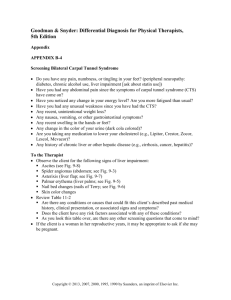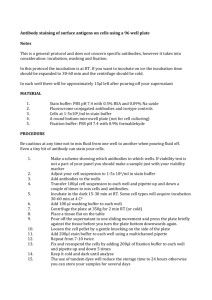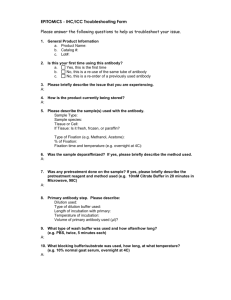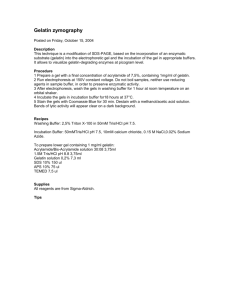- .- Faunce Project Sponsor
advertisement
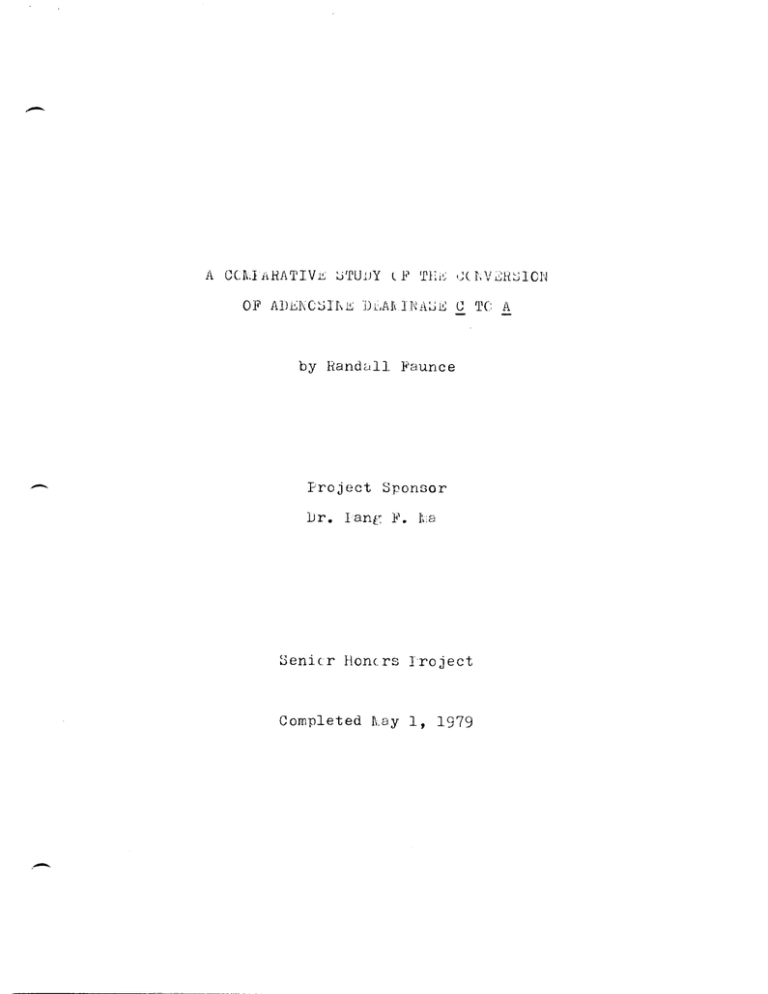
A COJ AHATIV ~ 0'rU1JY l.b'
Oli'
Al)~I\C~Ih~
by
-
'rEj~
I~U,
DLAl\ INA:J.c; C TC A
Rand~ll
Faunce
Project Sponsor
Senicr Honers Iroject
Completed kay 1, 1979
.-
V ~H~lCN
1
.l
0
A COMPARA TIV E
~)TUJjY
OF THE CCNVERSICN
OF ADENOSINB lJBANJINASE C TO A
PURPOSE:
This experiment was designed to fulfill two functions.
A conversion factor would be reacted with C form adenosine
deaminase (to be further refered to as AD-C) obtained from
various sources.
An attempt would also be mad.e to isolate the
conversion factor (refered to as C.F.) from a cancerous tissue.
Nishihara, et.al., isolate6. the protein C.F. which catalyzes the reaction
2 AD-C + C.F.
= AD-A
(A form).l
This
reaction is the basis for this study.
-
Iv,ETHOJJS AND PROCEEDURES:
Isolation of C.F. and AD-C
50 grams of humun liver was homo[enized with 250 ml
doulJle uistilled water in an ice bath.
centrifuged at 39000
£,'
s for 40 min.
The sample was then
Supernatant vias suved
and a 40% solution of ammonium sulL1te (NH ) 2S04 was reached
4
by adding wtile stirrineo and refrigeraiing (0-4 °C). The salt
Golution was allowed to stir for a minimum of 24 hrs.
then centrifu{':ed again.
~)u~'ernatant
It was
was salted to 60% solution,
allowed to :::tir, centrifuGed, sUrJerni!t8nt again salted (to
80%), allowed to stir, anu centrifuged.
The resulting precip-
itate was thmdissolved in a minimum amount phosphate buffer
(0.05 M, pH 7).
The sample was then frozen for storage.
A sample of cancerous liver was prepared in the same
manner.
Samples of hum, n DtomGeh, rabbit intestine, and rat
-
intestine were
ChOSJD
for sources of AD-C due to the GI
tractt~
general high acti vi ~y for this enzyme! ~)ample tre2 tment was
2
8imilar to th; t dcscribeG bbove.
slightly alterc-'d.
45-55-b5~
cut,
r8t source
but the
siJrnple
WelS
the result of a
the 55-65% cut beinp the AD-C source.
Wc'S
sam~'le
The r;lllbi t
The salt percentages were
n
45-G57~ cut.
lJu.rr,[)n storr:ach
W'-S
a
The
40-6010 cut,
hvd to be further proceGued due to a presence
of AD-A.
oeveral 50 ul portions were pcu3sed throuFh a Bio-Gel
column. li1ractions colI e ct ed showin£ A1J-C acti vi ty were pooleu,
ultrafiltrated (40 psi, 150 ml to appro 5 ml),
an~
stored.
A cornercial grade calf AD-C, obtained from 0ifJI18 Chern. Co.,
was &lso used.
Colurr;n Freparation
Bio-Gel A (pre-swelled) for a 50 x 0.9 cm column was
supplied by Bio-Had Labratories.
-
Sephadex 200 G for a 30 x 0.6
cm columh was obtained from Pharmacia.
Both columns were
equilibrateCi with 0.05 M phosphate buffer for a minimum of
24 hra.
The columns were calibroted with Blue Dextran and
Cytochrome C protein markers.
The Bio-Gel column showed peak
Dextran absorbance, as well as peak AD-A activity at fraction
22.
AD-C
a~a
Cytochrome C peaked at
respect.ively.
fr~ctions
34 and 36
In general, AD-C fractions collected were between
31-48.
The sephadex column
plots.
~arker8
WbS
useu f0r the actual assay
peaked as shown (FiC. Jl).
Asr:,ay l'/,ethod
Activity assays were executeo in the mBDner described by
~i.CJ. 3
Instruments involved were a Gilfcru 240 spectrophotometer
with accompanying 6050 chart recorder. All readincs were made
at 265 nm with a chart sreed of 30 in/hr and u temperature of
40°C.
-
Reaction Conditions
Heaction of C.F. with the various samples of AD-C was
carried out in a test tube-water bath system.
Bath temperature
3
W[IS
m1lintained at 25 0 C.
C.F. und AD-C source werL' pipetted
into the test tube anci left in the bath for one (1) hour.
Incubations were also carried out with phosphate buffer and
each source of AD-C or C.F. as controls.
RE:..iULT0:
Numerical values for activity are direct readings from
assay chart.
minutes,
th~s
Each fraction was allowed to react for three
all values equal the change in units optical
oensity over a three minute period.
This effectively st.and-
ardizes measurements for a qualitative comparison.
Normal liver C.F., incubated with' buffer, showed little
acti vi ty over the first ei{'ht to ten fracti (·ns and none in
the final five (Fig. #2).
Human stonlach AD-C with buffer
displayeu peak activity at fraction 11 with no AD-A activity
-
present (Fig. #3).
Reaction of the C.I". with stomach AD-C
yielded an apparently complete conversion of the 0 form enzyme
to the A (F:Lg.
if 3) •
It wc.! s thj, s re suI t thCi t confirmed the
presence of C. F. in the liver HL;mT,le.
The C.F. was then reacted with the calf AD-C.
convErsion resulted (Fip.
J4).
An incomplete
Another inCUbation was per-
fcrme~
this time with a 2::1 volumetric ratio of C.F. to the
Al,-C.
Conversion
\'leiS
much more complete (Fig. ;/4).
Incubation of the C.P. with the rabbit AD-C, like the
human stomach, showed complete conversion with a 1::1 ratio
(Fig. i/5).
The rat AD-C was active witt very small
(10 ul pcrtions).
~mounts
of sample
For ease of handlinp, 40 ul of buffer was
incubated wi th the 10 ul sample.
uisplCtyed high AD-C activity.
C.F. to AD"'C was incubated.
This small ,;mount still
As a result, a 4::1 ratio of
The resulting assay showed no
conversion at al~ (Fig. #6).
-
'11he ct1ncerous liver-buffer incubation yielded a generally
4
consistent, 10w activity (Fig. #7).
Incubation with human
stow:Jch AD-G showed a po:owible purtial ccnvt:ruion, although
re~ults
may be more confidently explvineu as a simple additive
effect (Fie. ~8).
DI:JCUSSICN:
There is no doubt that C.F. is present and readily obtainable from tissues other than human lung, the source of
Nishihura's C.F. I
was very active
~nd
Although in cruder form, the liver C.F.
not limited to reaction with human sources
of AD-C.
Due to the lack of conversion of the rat AD-C, however,
it must be theorized that the rat intestinal enzyme is a
different protein of the sume general size and function as
that found in the othbr sources tested.
If this is the case,
it is possible that one sample source m~jy contain more than
one form of AD-C. This would explain the incompleteness of
conversion of the calf enzyme (incubation of a 3::1 ratio of
C.F. to AD-C yeilded results similar to that of the 2::1
incubation, incomplete conver~~icn).
The reBul ts of thE; cancerous liver study indicate an
app2rent lack of C.F. in such tissues, prov~ded it may be
accepted thht the incubation curve is simply an additive one,
composed of the two samples involved.
This is certainly a
more appropriate interpretation due to peak placement and
separation more closely matching the liver-buffer incubation
thC:<.n other I,D-A/AD-C peaks.
The lnck of C. :v..... in thi.s cancerous
tissue may explain the difference in the ratio of AD-A to
AD-C found between normal anc cancerous tissues in a previous
stuoy.4
Several questions ,: re now rai sed.
..-
Is there a second form
of C. F.? Cc:.n one form of AD-C be converted to the other? Is
the lack of C.F. in cancerous tissues a symptom or possible
5
cause of the cancer?
Answers will be obtained throuph further
experimentation.
REF.t;;Hm<cJ:.::) :
1.
H. NishihAra, H. Akedo, S. Ishikawa, K. Shinkai,
2.
3.
Biophys. Acta vol. 302 (1973), p. 429.
vel. 6 (1975), p. 281.
1'. ~;a , T. !\'lagers, Int. J. Biochem.
f. II'ia, J. Fisher, Biochim., Biophys. Acta, vol. 159 (1968),
4•
p. 1 ~5 3.
H. Akedo, H. Nishihara, K. Shinkai, K. Komatsu, S. Ishikawa,
Diochim., Biophys. Acta
-
-
vol.276 (1972), p. 257.
Biochim.,
C.YT/OC~~" c.
...\
\.
.
Fig. #1
A mixture of
75 ul of each marker
protein
WaS
added to
the column. Absorbance
readings for Blue
Dextran were mude at
•
a wavelength of b25.nm •
Cytochrome C reaaings
were made at 410.
Due
to placement of the
Blue Dextran peak, all
subsequent assays
•
9Lue~TRAN
a.roo
-
began with f'ra cti on 4.
.
"
) \.~.
,.
.__ .----_4-
8
FRACTION
-.~
--
tfVMI\N t.'''6A./SUFF&R
,-----,-----.--.-.
5'
.-1
10
15
F~~CTION
Fie. #2
buffer.
Incubation of 50 ul of human liver with 50 ul phosph2te
This and all followinr plots were run on a Gilford
240 spectrophotometer Emu 6050 chart recor--d.eJl'. The followinp'
-
ccndi tions were employed ttlrour:h
the stUdy:
Wavelength 265 nm,
Chart ~peed 30 in/hr, Sensitivity Ratio 0.50, 100 ul fraction
s2mple re[J cted with 3.0 ml Adenosine, Temper:c.ture 40°C.
10
>-"?
f-2:
:;~5
-0
t-.
•
UO
____ 0
____
...............
.~.
«~
.-----.
~ /" --.-._-.-.-------......
•
.
~
.-
--
5
.. _ _ •
.
I
~ • STOf'\A(.H/BuFFtIl
:=:::". S'VOH~lI/c. F.
10
15
F-U!.1lO..bL------
Fif· #3
Incubation of 50 ul human stomnch /
buffer and 50 ul stomach /
50 ul phosphate
50 ul human liver.(C.F.).
6
2
.-_e __ ·~
~.
I
-
10
5
Fif':.
;;4
I
11)
F-RAC.TIO~
Incubation of 50 ul CEllf / 50 ul buffer of which only
75 ul was added to the column (instead of tctal), 50 ul culf /
50 ul C.F. (75ul aaued to column) , anG 50 ul calf I 100 ul c. F.
Note the incomplete conversion in both C.F. incubations.
16
.~
.
12
"....
:>l-
>
-
lv
q:
z
i:
".,
"ci
d
8
~
~ "---·-·---.~81l'/Bvr:-FE~
.
.~
4
t
/
.-.--.
.~
• ____
/C.
.'-- ..---.~
,
R"BBIT
F.
10
5
-
,,---0
f'MCIJQN
Fir. #5
Incubation of 50 ul r8bbit intestine /
(75 ul added to column) Dnd 50 ul rabbit /
adced to column).
50 ul buffer
50 ul C.F. (75 ul
2"
--
5
10
15
F"RACTION
Fig. //6 Incubation of 10 ul rut intcGtine / 40 ul buffer and
10 ul rat / 40 ul C.1:;'o Note complete absence of conversion.
5
Incub~tion
FR"CTfON
of 50 ul
General activity is low.
,-
10
c~ncerous
75
humun liver /
50 ul buffer.
10
10
Flt4€TJON
15
Fir. 118 Inc!ubatiun of 50 ul human stomach / 50 ul buffer and
50 ul stomach / 50 ul cancerous liver. Note lECk of AD-A
activity and maintained AD-C activity in stomach / liver plot.

